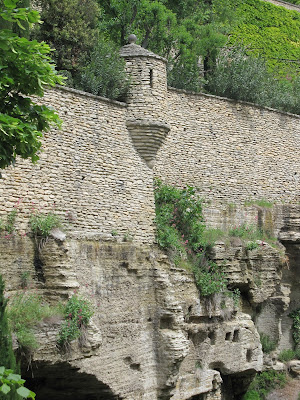


After seeing the caves formed by the underground river, we went to Fontaine de Vaucluse, a town built on the banks of the river that once flowed under the limestone massif and formed the caves. This river is deep and fast, and there are many kayak-rental places along it, and white water for risking your neck in.
Ria and I wandered around for a while, enjoying the beauty of the river and the trees lining it, then headed to a restaurant right on the river. It's pictured below, as is the bottle of wine I had, with a drawing on the label of the restaurant itself. During lunch it poured rain, absolutely dumped, and as soon as we'd finished, the rain stopped and the sun came out. We spent the whole afternoon walking, playing in the trees, and (Ria) photographing dogs.







































